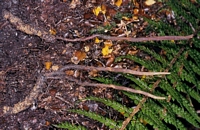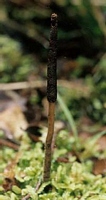Cordyceps robertsii
(=Ophiocordyceps robertsii)
|
 | This is the largest and most readily seen of about 15 species of Cordyceps recorded in New Zealand. It was also the first New Zealand fungus to be described as new, in 1836. It parasitizes burrow-dwelling caterpillars of forest-inhabiting species |  | |
|

|

|